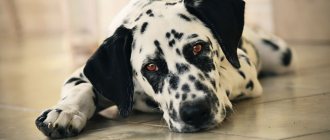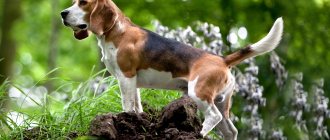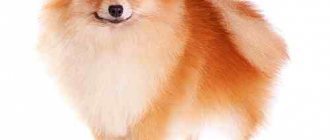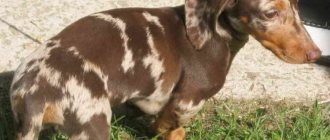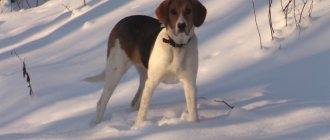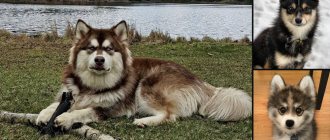Required elements
Despite the huge variation in colors, Beagles are allowed to have a certain number of colors. These include black, white, red, brown and all their shades. The arrangement of tones is not regulated by canine associations. They do not prioritize colors, allowing all possible options characteristic of hound breeds. Most organizations consider only one color to be wrong - liver (or chocolate).
The only constant elements of each suit are the white tip of the tail and the possibility of having specks (except pure white). Other colors are not allowed at all, as is directly stated in the breed standards.
Tricolor
Dogs with a tricolor are born black and white. The reddish or brownish markings are fully formed when the dog is one year old. Sometimes puppies are born with three shades at once. Young animals may have white hairs in the black zone, but this feature is temporary.
Black-red-white. The most common color variant of the Beagle, which is why it is called “classic” or “traditional”. The most common color is anthracite-fiery white. The colors are evenly distributed throughout the body, the boundaries of each shade are blurred. In contrast to the “classics” there is a weakened (blurred) tricolor. There are quite a lot of variations of weakened shades.
Blue tricolor
The blue tricolor is due to genetic characteristics. The gene “lightens” the dog’s colors, turning black into gray and brown (red) into cream. When the color is blue, the iris of the eyes also changes. It becomes lighter - closer to yellow. The nose also acquires a lighter pigment (gray or slate). Often, it is the shade of the nose that can determine the blue color of a Beagle puppy. The color is otherwise called smoky, gray or silver.
A genetic mutation can lighten the black gene to light gray shades. The silver color is called lilac tricolor (“khaki” or “mocha”). Sometimes puppies are born traditionally tri-colored, but later the white coat becomes covered with small spots. This feature is called blue-freckled color.
Chocolate
Chocolate (liver) tricolor also belongs to the weakened type. In this case, the black gene takes on a brown tint, completely replacing all dark tones. The chocolate version is characterized by the fact that it goes in combination with the light green eyes and brown nose of the Beagle. The black color is lightened to varying degrees: from dark liver to almost creamy shades.
A variation of the chocolate tricolor is the lilac color. “Purple Chocolate” is unique in that the brown tint goes together with blue. This combination forms a whole shimmer of colors, which is called “isabella”. The chocolate (liver) color is not recognized by the FCI and therefore not in the UK. All puppies of this color are completely discarded and are not allowed for further breeding. The situation is the opposite in the USA and Canada - the color is officially registered, and “liver” Beagles often receive high marks from experts.
The chocolate tricolor is considered a disqualifying fault for two reasons: it may indicate that the dog is not purebred, or that the individual has poor vitality. The accumulation of recessive genes can lead to subsequent genetic abnormalities in other generations.
Spotted
The spotted color belongs to the tricolor group. In other words, it is called torn or open. The dominant color is white, which divides the “traditional” version of the tricolor, turning it into spots. Sometimes white covers almost 80% of the dog's body, leaving a few small black or tan colored markings on the Beagle.
Tricolor
The colors are combined and interspersed in the most bizarre way, but the tip of the ponytail will always have a white color. The spots come in different sizes, and the dominant shade will add an increasingly unique combination to the beagle.
If there is more white, the animal will look very harmonious and innocent, while mixtures with black will add mischief to the appearance. By the way, black will also not always be exactly in its intensity - sometimes the color can be paler, closer to gray, sometimes just charcoal, and sometimes even with a blue tint, which is also called “raven wing color.” The nose is the same as in the previous case, black.
Two-color
Bicolor is the color of a Beagle, consisting of two colors - white (closer to cream) and a shade of red. The pigment responsible for redness manifests itself in different intensities:
- red;
- ginger;
- citric.
The division of tones is conditional; there are transitional variations between them. The standard allows all shades from red to light lemon. It is bicolor that is most popular in the UK.
Red is considered the rarest. Its saturation is often compared to brick, but the color is called “mahogany” in another way. The remaining shades between red and lemon are variations of the red tone. Very often the light red color is mistaken for the lemon Beagle color.
Bicolor puppies are most often born completely white and darken closer to the age of one year. However, there is still a way to determine the exact color color: the darker the nose, the lighter the coat. The lemon white Beagle has nose pigment closer to black. Red and white dogs have a more light brown nose.
Sometimes the color of the nose can also change color (from light to dark). This can happen in bitches, in whom the phenomenon depends on the hormonal cycle.
White - red
It is the white and red one that is most often found among bicolor Beagles. It exists in a wide variety of variations: from dark, rich tones to almost pale cream shades.
Interpretations of the red bicolor are very often subject to doubt and controversy. It is easy to confuse it with the unique lemon color or classify the bright shade as a rare red and white. Only experienced beagle breeders are able to independently determine the color of a dog.
It is incorrect to consider the dominant color of the Beagle to be pure white. It is slightly darker than snow white and closer to a light cream or creamy shade. The combination of light cream color and white is called lemon.
Citric
Lemon color is considered the unique color of the breed. It is very difficult to identify, especially for a novice breeder. Lemon color is achieved by maximizing the lightening of the gene responsible for dark colors. Puppies with this color have a dark (almost black) nose from birth.
Lemon shade is a pale cream color that is only slightly darker than base white. A more saturated tone already belongs to red-and-white, although many mistakenly classify it as “lemon”. The principle of determination is simple - the lighter the red pigment, the closer it is to lemon.
Speckled or speckled
Specks are one of the options for displaying tricolor and bicolor. It is characterized by the presence of small black or red spots on the entire body (or in certain areas), as in the photo. The spots can form in large numbers (dense) or at a great distance from each other (sparse). Speckled is not a spotted variety and has nothing in common with the blue merle (merle) color.
Discoloration is genetically determined. You can recognize it in newborn puppies: their paw pads are never pink. The real mark appears already by 4-5 days from birth. Sometimes puppies acquire it at 6-8 weeks.
Motley
The variegated color occupies an ambiguous position. Essentially, it is a combination of two colors, but in different shades. Officially, variegated varieties are recognized only in the UK and the FCI. In total, they identified 3 varieties:
- badger motley (the rarest and most intense, black color predominates);
- hare motley (dominance of red color);
- lemon variegated (lightest).
Most pieds are recorded in the UK, but this does not mean that they are only found in one country. This variety is not rare and sometimes you need to look closely to see the variegated color in the muted tricolor.
Beagle breeders have never come to a consensus on which color combination to accept as a variegated color. Some argue that the presence of “agouti” is sufficient (zonal coloring - the tip of the hair is black, the rest is brown). Others believe that it is necessary to “mix” the brown and black hairs on the Beagle’s body.
With a variegated color, there is no pure snow-white color. It is more reminiscent of creamy or creamy (as is the case with standard bicolor). The color smoothly flows into another shade, which is similar to the usual classic tricolor.
Size
The breed acquired the name “beagle” because of its small size, because it is not for nothing that the word Begle from ancient English is translated as “small”.
Standard
According to the current standard, beagles should be small in size (male: 36–41 cm and female: 33–38 cm). The head of animals is in clear proportions and regular shape. The bump on the back of the head is pronounced, but not massive. The forehead is round and voluminous, and its length from the back of the head to the transition is extremely equal to the length of the face.
In turn, the front part, as well as the forehead, has no folds. The lips emphasize the shape of the head and are not loose, thick or saggy. Teeth without noticeable defects, strong and erect. The nose is wide, preference is given to black.
Representatives of beagles with light coat color are allowed a brown nose, but the complete absence of pigment on it (pink or cream color) is regarded as a clear fault. The ears are soft, the ends are necessarily rounded, reaching the tip of the nose in length. The eyes should have a friendly and expressive look, with a color ranging from brown to hazel or amber.
Body size - considers the proportionality of the sternum in relation to height. While the dog is searching, folds of skin are clearly visible in the neck area, and when running, the nose is directed towards ground level, but the neck is in a slight bend. The paws are often round in shape, the toes are clearly bent, their pads are soft and covered with a thick layer of skin, and the claws are short. The beagle's tail should be strong and stand vertical to the ground, without bends or any defects, even, with a white tip. When at rest, it lies along the line of the back; when moving, it is in the “up” position, without bending into a ring.
Anything that differs from the current breed standard is considered to be a defect and vice.
Brown
Almost all cynological organizations, when describing the Beagle, require the presence of a white color. However, there are individuals without this shade. American and Canadian conformation does not require the breed to have a white color (and the same tip of the tail). Professional hunters in the United States can find bicolor Beagles, which have a dominant red or brown tone.
The complete absence of white color often raises doubts among experienced dog breeders. They suspect such Beagles of being unclean and believe that the dogs have been infused with the blood of other breeds. This theory has a place to be, since hunters do not focus on the exterior and focus on the hunting qualities of the dog.
Character and training
The positive and good-natured nature of Beagles (naturally) has flaws and nuances. Any dog, with a dog's attitude, can be brought to life by biters. And we are not talking about the fact that the pet could protect the owner if necessary. Beagles are capable of defense, fierce and merciless, but mental balance smooths out possible “roughness” in family relationships. Representatives of the breed show aggression towards humans only in the most extreme cases, and even newborn children are safe around them. The nuances we are talking about relate to comfortable coexistence.
Since the Beagle is a hunting dog, the breed's shortcomings appear precisely against the background of its innate qualities. If you underestimate your strength or the amount of free time, you can say goodbye to shoes, furniture and all other household items that can be chewed, torn and slobbered on.
Beagle puppies are restless and curious, but they are many times “safer” than teenagers. Not every new owner, who has experienced the joy of buying a puppy and suffered from puddles and piles, will be able to endure the collapse caused by a grown-up pet. If you are not ready to come to terms with material losses in advance, do not get a Beagle.
Is it possible to reduce the expected (guaranteed) damage? - Easily! Training, walking, sports and any other entertainment with your dog that comes to your mind. Do you like to ride a bike? – Great, for a Beagle even 10 kilometers is not a detour. Playing with a ball, agility, coursing, and even winter sledding rides for children - everything is suitable.
Training a Beagle requires some experience and a special approach. A four-legged animal bursting with energy will not work on the site, no matter how hard you try. The monotony of exercise is even worse than the lack of exercise and is guaranteed to lead to the fact that the pet will run away for fun. And don’t let the size of an adult dog deceive you, it has much more energy than you might think.
Representatives of the breed become quite attached to the owner, but remain responsive and friendly to all family members. They (usually) do not show aggression towards strangers; in extreme cases, they are distrustful and reserved. In relation to dogs, cats and other inhabitants of the home, the Beagle is indifferent. The standard requires the breed to be completely indifferent to livestock and poultry.
Does black exist
There are no completely black Beagles. Black pigment can dominate or, conversely, be suppressed by red or white. Even the rare black bicolor should have white spots or large markings.
Rare bicolor variant
Sometimes puppies are born black and white, but with small brown spots. The spots disappear over time. White takes on a creamy hue. These dogs are black and white in color. The black pigment dominates the rest and can occupy up to 80-90% of the dog's entire body. The white remains in the form of several marks.
The black and white bicolor is officially recognized, but is very rare. Dogs with this color practically never appear at shows.

